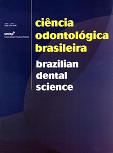Heterotopic osteogenesis induced by implantation of allogenic bone matrix graft into mouse muscle perimysium. A morphometric study
DOI:
https://doi.org/10.14295/bds.2004.v7i1.678Abstract
Heterotopic osteogenesis induced by allogenic bone matrix graft in the mouse muscle was analyzed by radiography, morphology and morphometry. Diaphyses of the femurs of 18 fifty-day-old mice were demineralized with 0.6 M HCl and implanted into the adductor muscle of the right thigh of 36 mice. Two, 5, 7, 14, 21 and 28 days after implantation, groups of 6 animals/period were sacrificed and radiographied, and specimens were collected and processed histologically. The presence of mineralized material in the graft was detected by radiography only on day 21. Morphologic and morphometric analysis of the histological sections showed that: a) the matrix remained intact up to day 7, followed by resorption of 16% by fibroblast-like mononuclear cells up to day 28; b) cartilage tissue was first detected on day 14 at the highest quantity observed in the experiment, occupying 5% of the graft volume and containing 4 x 102 chondrocytes/mm3 graft, followed by a substantial decline up to day 28 when it reached a volume density of 0.5% and 0.6 x 102 chondrocytes/mm3; c) bone cells and matrix were detected in minute amounts from day 14 on, with a volume density of 0.4% and containing 0.2 x 102 cells/mm3, which increased about 15 and 32 times, respectively, by the end of the 28-day, reaching 6% of the graft volume and 6 x 102 cells/mm3. We conclude that, despite the relatively low percentage of graft matrix resorption (total of 16%), the matrix was able to induce all events of the endochondral ossification cascade, i.e., formation and subsequent disappearance of hyaline cartilage, osteoblast differentiation, new bone formation and, later, the formation of hematogenous bone marrow.
Downloads
Downloads
Published
How to Cite
Issue
Section
License
Brazilian Dental Science uses the Creative Commons (CC-BY 4.0) license, thus preserving the integrity of articles in an open access environment. The journal allows the author to retain publishing rights without restrictions.
=================




























